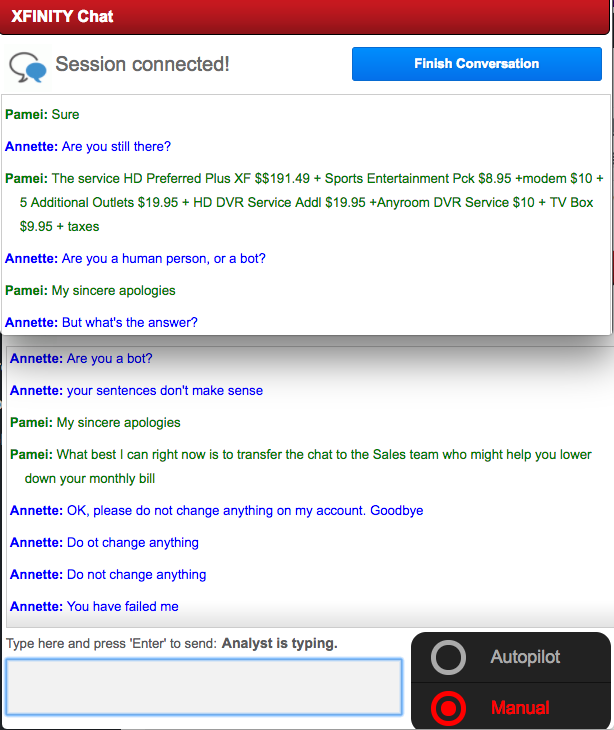In a fight between Comcast and a bot, my mom loses

“Are you a human,” I asked the Comcast live-chat rep, “or a bot?”
They responded, “My sincere apologies.” But that didn’t answer the question. I asked again. “My sincere apologies,” they replied.
The bizarre exchange came during my experience using a bot to deal with Comcast (CMCSA). The experience didn’t go well, but provides a useful example of the tasks that some companies are trying to use bots to improve.
Ever since Facebook (FB) unveiled Messenger Platform, an API for businesses to create chat bots that live inside Facebook Messenger, startups and big corporations alike have sought to find compelling use cases for bots. Trim, which offers a finance bot that monitors your bank accounts, thinks it has one: Comcast service calls.
Trim first launched one year ago (before Facebook went big on bots) as an SMS bot that would send you text message alerts about big deposits or big charges to your bank accounts. Customers can still use Trim that way today. But Trim says the majority of users now come through Facebook Messenger, which Facebook made into a separate app two years ago and recently hit 1 billion monthly active users. Trim says 650,000 people have used its bot.
When you sign up and link Trim to your accounts, it finds all your monthly subscriptions—the function that CEO Thomas Smyth says is most helpful for people because it reveals to them something they are paying for that they don’t need. If you wish, Trim can cancel subscriptions for you. (The most frequently canceled? Audible, Smyth says.) But Smyth wanted to find another way for Trim to offer value. “It does the subscription canceling and that’s cool, then you get the updates and that’s cool, but what we hear from people is, ‘Hey, do more work for me,’” Smyth says. “And it felt like Comcast was a great place to start.”
Trim’s new, separate bot for dealing with Comcast functions as a Google Chrome extension. Comcast, which has some 23 million internet customers and 11 million phone customers, has consistently been maligned for its enraging customer service. In 2014 it was named Consumerist’s Worst Company in America and in 2015 it ranked in last place in the American Customer Satisfaction Index. So the idea of letting a bot deal with Comcast for you has obvious appeal.
For now, the bot can’t handle specific issues with your account like slow internet or a service outage. It can only try one thing: to save money on your bill. That’s a goal any cable customer can get behind.
But in a Yahoo Finance test run, the bot failed.
Putting a bot to the test
I don’t have Comcast (in my Brooklyn neighborhood, my only option for internet service is Time Warner, which sure seems like a monopoly, but that’s a topic for another article) so I signed in to the bot using my mom’s Comcast account (with her permission). She lives in Massachusetts.
Trim begins by giving you some tips: “The longer you chat, the better chance you have of getting a deal,” it instructs. “Beware the upsell from Comcast,” it warns, encouraging you to watch out of “offers for additional phone service.” Once you’re ready, it initiates a web chat with a Comcast rep. While it handles the chat, you have the option to play old-school games like Tetris or Snake, which Trim layers over the chat box.
The Trim bot starts for you thusly: “Hello, I am a loyal Comcast customer. I recently learned that other providers in my neighborhood are offering a better price for the same service. Can you help me lower my bill while maintaining the same level of service?” That sounds fine (if a bit stiff), except that the Trim bot keeps reiterating that message at random times. As soon as “Pamei,” the Comcast rep, responded, Trim wrote again, “I’d like to decrease my bill!”
Subtlety is not this bot’s strong suit.

The bot sends messages on your behalf in “autopilot” mode, but at any time you can switch to “manual,” in which you write and send the messages. I had to do that a few times just to stop the bot from continuing to overplay it. When you toggle into manual mode, a pop-up from Trim alerts you again, like an anxious parent: “Don’t get upsold! Comcast agents will commonly try to upsell you… We recommend you say something like ‘Under no circumstances do I want to upgrade my account.’”
The rise of third-party negotiators
Might Comcast have an issue with an outside service coaching customers on how to avoid getting suckered? The company declined to comment, but Smyth says Comcast is onto the game: some Trim users have reported the Comcast rep asking them if they’re using Trim. In response, the Trim bot gets snarky, responding, “Everyone you chat with today is using Trim.”
Smyth says he can imagine Comcast being displeased with the bot’s existence, but defends it this way: “If you’re using an auto-fill function on a web site, no one says you’re going too quickly. Or you can print out scripts that you can find online that help a call go faster, no one says you can’t do that. I think using a bot to get through a service call is going to be the norm, moving forward.”
It won’t be the norm if the bot can’t adequately mimic a human.
Every time I jumped back into autopilot, the bot would remind the Comcast rep that I wanted to lower my bill. I was cringing. Meanwhile, Comcast’s “rep” behaved like a bot as well, giving non-answers, in stilted English, to my questions. (As noted at the beginning of this story, I asked Pamei twice if she is a bot, and she only replied, “My sincere apologies.”) The reps are not bots, but are instructed to stick so closely to script that they might as well be bots.
Watching the Trim bot deal with the Comcast rep for me was like watching two bots argue with each other. They were not on the same page, to say the least.
After 20 minutes, Pamei of Comcast said, “What best I can right now is to transfer the chat to the Sales team” and I gave up.

While the bot didn’t help me save on my mom’s bill, Smyth says it has had a 70% success rate with getting bills lowered, and has saved subscribers an average of $10. Some 3,000 people have tried out Trim’s Comcast bot.
Trim’s hope is to create specified bots to deal with many different service utilities. “We want to see how this goes,” Smyth says. “And if it’s super successful, then it’s a model we want to work on further.”
There are already more than 11,000 bots inside Facebook Messenger. They let you do things like order pizza from Domino’s, order flowers from 1-800-Flowers, or order an Uber ride. The question is whether doing those things inside Messenger is really any faster or easier than using a phone or the specific apps that exist for those services. Big banking and payment giants like MasterCard and Bank of America are rolling out bots to run your finances for you—an even riskier gambit.
Smyth believes the next step for chat bots is not bots that speak to the user, but bots that speak to other businesses. “You are going to see an explosion of bots that talk to a business for you,” he says, “because no one likes picking up the phone and making this call.”
That’s true, but for consumers to turn to bots on a mass scale, they will first need to trust them.
—
Daniel Roberts is a writer at Yahoo Finance, covering sports business and technology. Follow him on Twitter at @readDanwrite.
Read more:
There’s one big problem with Facebook Messenger bots
MasterCard, Bank of America want you to let chat bots handle your finances
Facebook’s embrace of bots is about making Facebook more human

 Yahoo Finance
Yahoo Finance 